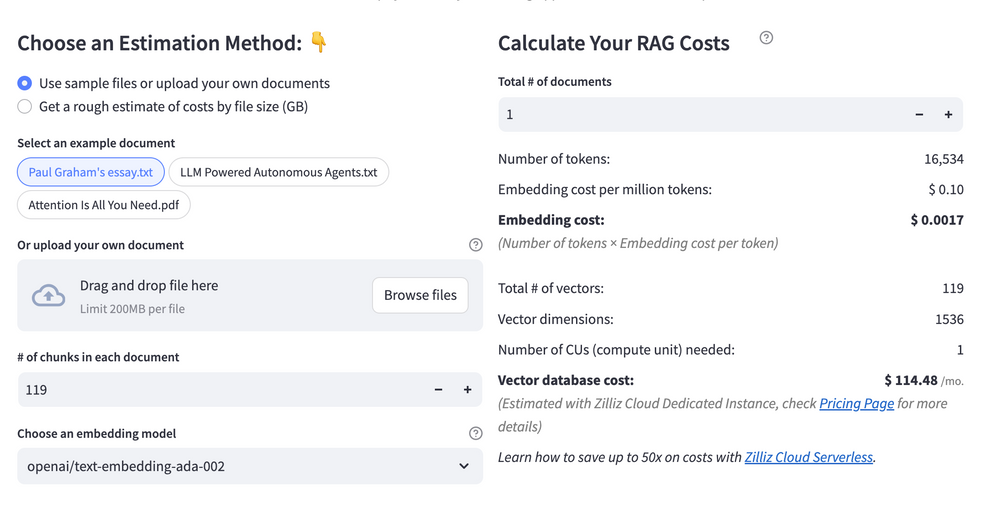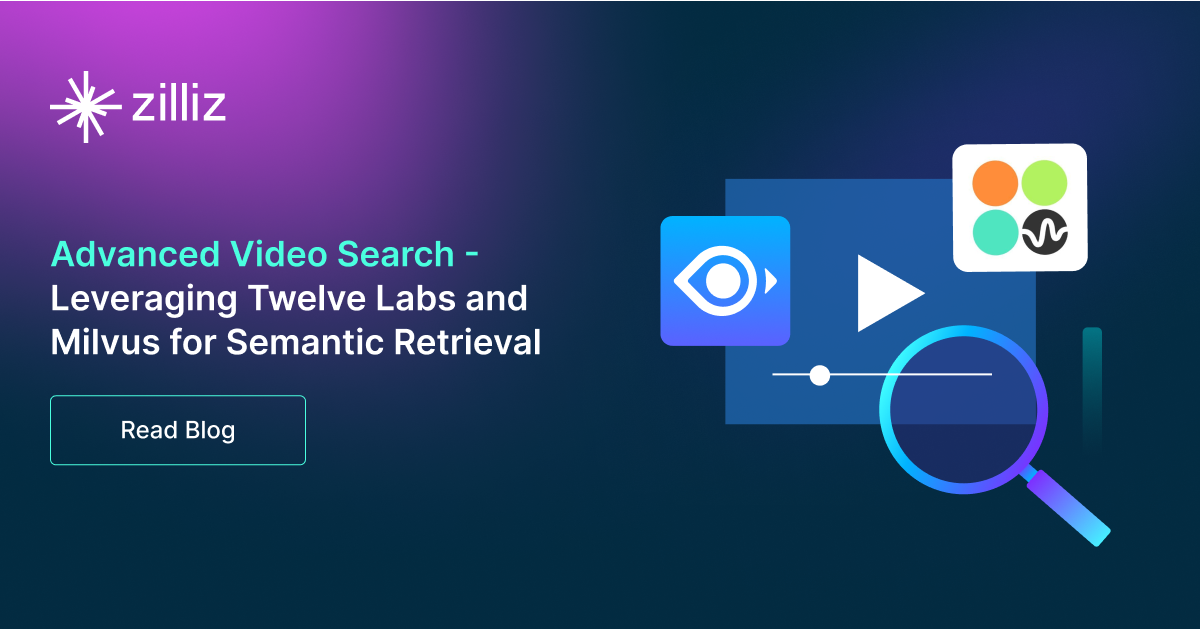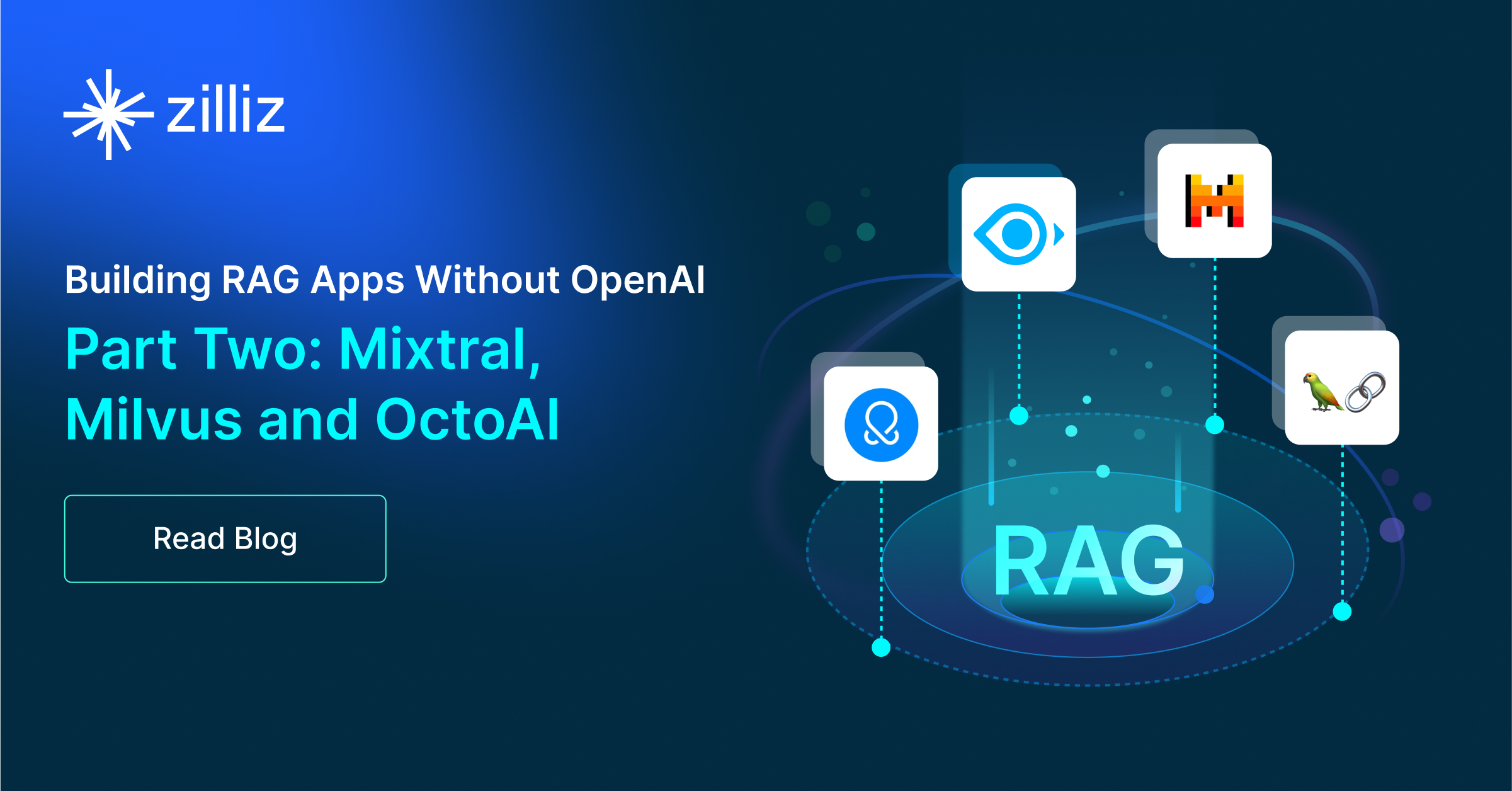Build RAG Chatbot with Haystack, Pgvector, STACKIT E5-mistral-7b-instruct, and STACKIT e5-mistral-7b-instruct
Introduction to RAG
Retrieval-Augmented Generation (RAG) is a game-changer for GenAI applications, especially in conversational AI. It combines the power of pre-trained large language models (LLMs) like OpenAI’s GPT with external knowledge sources stored in vector databases such as Milvus and Zilliz Cloud, allowing for more accurate, contextually relevant, and up-to-date response generation. A RAG pipeline usually consists of four basic components: a vector database, an embedding model, an LLM, and a framework.
Key Components We'll Use for This RAG Chatbot
This tutorial shows you how to build a simple RAG chatbot in Python using the following components:
- Haystack: An open-source Python framework designed for building production-ready NLP applications, particularly question answering and semantic search systems. Haystack excels at retrieving information from large document collections through its modular architecture that combines retrieval and reader components. Ideal for developers creating search applications, chatbots, and knowledge management systems that require efficient document processing and accurate information extraction from unstructured text.
- Pgvector: an open-source extension for PostgreSQL that enables efficient storage and querying of high-dimensional vector data, essential for machine learning and AI applications. Designed to handle embeddings, it supports fast approximate nearest neighbor (ANN) searches using algorithms like HNSW and IVFFlat. Since it is just a vector search add-on to traditional search rather than a purpose-built vector database, it lacks scalability and availability and many other advanced features required by enterprise-level applications. Therefore, if you prefer a much more scalable solution or hate to manage your own infrastructure, we recommend using Zilliz Cloud, which is a fully managed vector database service built on the open-source Milvus and offers a free tier supporting up to 1 million vectors.)
- STACKIT E5-mistral-7b-instruct: A 7B-parameter instruction-tuned language model optimized for task-specific guidance and multi-turn dialogue. It excels in understanding complex prompts, generating coherent responses, and adapting to diverse applications like chatbots, automation, and content creation. Ideal for developers seeking efficient, scalable AI solutions with minimal computational overhead.
- STACKIT e5-mistral-7b-instruct: A 7B-parameter language model optimized for instruction-based tasks, delivering efficient, context-aware responses. Excels in natural language understanding, scalability, and low-latency performance. Ideal for enterprise automation, customer support, technical documentation, and generating structured outputs from complex prompts. Combines precision with adaptability for business-critical AI applications.
By the end of this tutorial, you’ll have a functional chatbot capable of answering questions based on a custom knowledge base.
Note: Since we may use proprietary models in our tutorials, make sure you have the required API key beforehand.
Step 1: Install and Set Up Haystack
import os
import requests
from haystack import Pipeline
from haystack.components.converters import MarkdownToDocument
from haystack.components.preprocessors import DocumentSplitter
from haystack.components.writers import DocumentWriter
Step 2: Install and Set Up STACKIT E5-mistral-7b-instruct
STACKIT is the cloud and colocation provider of the Schwarz Group. We can use different models on its cloud services with ease through its API.
pip install stackit-haystack
from haystack_integrations.components.generators.stackit import STACKITChatGenerator
from haystack.dataclasses import ChatMessage
generator = STACKITChatGenerator(model="intfloat/e5-mistral-7b-instruct")
Step 3: Install and Set Up STACKIT e5-mistral-7b-instruct
pip install stackit-haystack
from haystack_integrations.components.embedders.stackit import STACKITTextEmbedder
from haystack_integrations.components.embedders.stackit import STACKITDocumentEmbedder
text_embedder = STACKITTextEmbedder(model="intfloat/e5-mistral-7b-instruct")
document_embedder = STACKITDocumentEmbedder(model="intfloat/e5-mistral-7b-instruct")
Step 4: Install and Set Up Pgvector
To quickly set up a PostgreSQL database with pgvector, you can use Docker:
docker run -d -p 5432:5432 -e POSTGRES_USER=postgres -e POSTGRES_PASSWORD=postgres -e POSTGRES_DB=postgres ankane/pgvector
To use pgvector with Haystack, install the pgvector-haystack integration:
pip install pgvector-haystack
import os
from haystack_integrations.document_stores.pgvector import PgvectorDocumentStore
from haystack_integrations.components.retrievers.pgvector import PgvectorEmbeddingRetriever
os.environ["PG_CONN_STR"] = "postgresql://postgres:postgres@localhost:5432/postgres"
document_store = PgvectorDocumentStore()
retriever = PgvectorEmbeddingRetriever(document_store=document_store)
Step 5: Build a RAG Chatbot
Now that you’ve set up all components, let’s start to build a simple chatbot. We’ll use the Milvus introduction doc as a private knowledge base. You can replace it your own dataset to customize your RAG chatbot.
url = 'https://raw.githubusercontent.com/milvus-io/milvus-docs/refs/heads/v2.5.x/site/en/about/overview.md'
example_file = 'example_file.md'
response = requests.get(url)
with open(example_file, 'wb') as f:
f.write(response.content)
file_paths = [example_file] # You can replace it with your own file paths.
indexing_pipeline = Pipeline()
indexing_pipeline.add_component("converter", MarkdownToDocument())
indexing_pipeline.add_component("splitter", DocumentSplitter(split_by="sentence", split_length=2))
indexing_pipeline.add_component("embedder", document_embedder)
indexing_pipeline.add_component("writer", DocumentWriter(document_store))
indexing_pipeline.connect("converter", "splitter")
indexing_pipeline.connect("splitter", "embedder")
indexing_pipeline.connect("embedder", "writer")
indexing_pipeline.run({"converter": {"sources": file_paths}})
# print("Number of documents:", document_store.count_documents())
question = "What is Milvus?" # You can replace it with your own question.
retrieval_pipeline = Pipeline()
retrieval_pipeline.add_component("embedder", text_embedder)
retrieval_pipeline.add_component("retriever", retriever)
retrieval_pipeline.connect("embedder", "retriever")
retrieval_results = retrieval_pipeline.run({"embedder": {"text": question}})
# for doc in retrieval_results["retriever"]["documents"]:
# print(doc.content)
# print("-" * 10)
from haystack.utils import Secret
from haystack.components.builders import PromptBuilder
retriever = PgvectorEmbeddingRetriever(document_store=document_store)
text_embedder = STACKITTextEmbedder(model="intfloat/e5-mistral-7b-instruct")
prompt_template = """Answer the following query based on the provided context. If the context does
not include an answer, reply with 'I don't know'.\n
Query: {{query}}
Documents:
{% for doc in documents %}
{{ doc.content }}
{% endfor %}
Answer:
"""
rag_pipeline = Pipeline()
rag_pipeline.add_component("text_embedder", text_embedder)
rag_pipeline.add_component("retriever", retriever)
rag_pipeline.add_component("prompt_builder", PromptBuilder(template=prompt_template))
rag_pipeline.add_component("generator", generator)
rag_pipeline.connect("text_embedder.embedding", "retriever.query_embedding")
rag_pipeline.connect("retriever.documents", "prompt_builder.documents")
rag_pipeline.connect("prompt_builder", "generator")
results = rag_pipeline.run({"text_embedder": {"text": question}, "prompt_builder": {"query": question},})
print('RAG answer:\n', results["generator"]["replies"][0])
Optimization Tips
As you build your RAG system, optimization is key to ensuring peak performance and efficiency. While setting up the components is an essential first step, fine-tuning each one will help you create a solution that works even better and scales seamlessly. In this section, we’ll share some practical tips for optimizing all these components, giving you the edge to build smarter, faster, and more responsive RAG applications.
Haystack optimization tips
To optimize Haystack in a RAG setup, ensure you use an efficient retriever like FAISS or Milvus for scalable and fast similarity searches. Fine-tune your document store settings, such as indexing strategies and storage backends, to balance speed and accuracy. Use batch processing for embedding generation to reduce latency and optimize API calls. Leverage Haystack's pipeline caching to avoid redundant computations, especially for frequently queried documents. Tune your reader model by selecting a lightweight yet accurate transformer-based model like DistilBERT to speed up response times. Implement query rewriting or filtering techniques to enhance retrieval quality, ensuring the most relevant documents are retrieved for generation. Finally, monitor system performance with Haystack’s built-in evaluation tools to iteratively refine your setup based on real-world query performance.
pgvector optimization tips
To optimize pgvector in a Retrieval-Augmented Generation (RAG) setup, consider indexing your vectors using GiST or IVFFlat to significantly speed up search queries and improve retrieval performance. Make sure to leverage parallelization for query execution, allowing multiple queries to be processed simultaneously, especially for large datasets. Optimize memory usage by tuning the vector storage size and using compressed embeddings where possible. To further enhance query speed, implement pre-filtering techniques to narrow down search space before querying. Regularly rebuild indexes to ensure they are up to date with any new data. Fine-tune vectorization models to reduce dimensionality without sacrificing accuracy, thus improving both storage efficiency and retrieval times. Finally, manage resource allocation carefully, utilizing horizontal scaling for larger datasets and offloading intensive operations to dedicated processing units to maintain responsiveness during high-traffic periods.
STACKIT E5-mistral-7b-instruct optimization tips
To optimize STACKIT E5-mistral-7b-instruct in RAG, fine-tune the model on domain-specific data to align embeddings with retrieval tasks. Use dynamic chunking (256-512 tokens) for balanced context retention and computational efficiency. Apply quantization (e.g., 4-bit) to reduce memory usage without significant accuracy loss. Leverage instruction prefixes like "Retrieve relevant info for:" to sharpen focus. Implement cache layers for repetitive queries and prune low-scoring retrieved documents pre-generation. Monitor latency and adjust temperature (0.1-0.3) to balance determinism and creativity. Prioritize GPU memory optimization via mixed precision and kernel fusion.
STACKIT e5-mistral-7b-instruct optimization tips
To optimize STACKIT e5-mistral-7b-instruct in RAG, ensure input context is well-structured with clear document chunks (≤512 tokens) and metadata for precise retrieval. Use dynamic temperature and top-p sampling to balance creativity and relevance. Fine-tune retrieval thresholds to minimize irrelevant context injection. Batch process queries for GPU efficiency, and enable FlashAttention for faster inference. Precompute embeddings for static data to reduce latency. Regularly evaluate retrieval accuracy and model outputs via metrics like Hit Rate and ROUGE, adjusting prompts and chunk sizes iteratively.
By implementing these tips across your components, you'll be able to enhance the performance and functionality of your RAG system, ensuring it’s optimized for both speed and accuracy. Keep testing, iterating, and refining your setup to stay ahead in the ever-evolving world of AI development.
RAG Cost Calculator: A Free Tool to Calculate Your Cost in Seconds
Estimating the cost of a Retrieval-Augmented Generation (RAG) pipeline involves analyzing expenses across vector storage, compute resources, and API usage. Key cost drivers include vector database queries, embedding generation, and LLM inference.
RAG Cost Calculator is a free tool that quickly estimates the cost of building a RAG pipeline, including chunking, embedding, vector storage/search, and LLM generation. It also helps you identify cost-saving opportunities and achieve up to 10x cost reduction on vector databases with the serverless option.
 Calculate your RAG cost
Calculate your RAG cost
What Have You Learned?
By diving into this tutorial, you’ve unlocked the magic of building a RAG system from scratch! You learned how Haystack acts as the backbone, orchestrating every step of the pipeline with its flexible workflows and ready-made components. Paired with Pgvector, a powerful vector database, you saw how to store and retrieve embeddings efficiently, ensuring your system scales smoothly even as your data grows. The STACKIT E5 embedding model became your secret weapon for transforming text into rich, meaningful vectors, capturing the essence of your documents with precision. And let’s not forget the star of the show—the STACKIT Mistral-7b-instruct LLM—which turned those retrieved contexts into human-like, coherent answers, proving just how powerful open-source models can be. Together, these tools formed a seamless RAG pipeline: ingesting data, generating embeddings, querying the database, and synthesizing responses—all working in harmony to deliver accurate, context-aware results.
But this tutorial didn’t stop at the basics! You also discovered pro tips for optimizing performance, like tweaking chunk sizes and fine-tuning retrieval parameters to balance speed and accuracy. Plus, the free RAG cost calculator gave you a practical way to estimate expenses and plan budgets, making it easier to scale your projects without surprises. Now that you’ve seen the pieces come together, it’s time to take the wheel! Whether you’re building a chatbot, a research assistant, or a knowledge hub, you’ve got the tools and know-how to bring your ideas to life. Experiment, iterate, and push the boundaries of what’s possible—because every line of code you write is a step toward something incredible. The future of intelligent applications is in your hands. Start building, keep optimizing, and let your creativity shape the next generation of RAG-powered solutions. The sky’s the limit!
Further Resources
🌟 In addition to this RAG tutorial, unleash your full potential with these incredible resources to level up your RAG skills.
- How to Build a Multimodal RAG | Documentation
- How to Enhance the Performance of Your RAG Pipeline
- Graph RAG with Milvus | Documentation
- How to Evaluate RAG Applications - Zilliz Learn
- Generative AI Resource Hub | Zilliz
We'd Love to Hear What You Think!
We’d love to hear your thoughts! 🌟 Leave your questions or comments below or join our vibrant Milvus Discord community to share your experiences, ask questions, or connect with thousands of AI enthusiasts. Your journey matters to us!
If you like this tutorial, show your support by giving our Milvus GitHub repo a star ⭐—it means the world to us and inspires us to keep creating! 💖
- Introduction to RAG
- Key Components We'll Use for This RAG Chatbot
- Step 1: Install and Set Up Haystack
- Step 2: Install and Set Up STACKIT E5-mistral-7b-instruct
- Step 3: Install and Set Up STACKIT e5-mistral-7b-instruct
- Step 4: Install and Set Up Pgvector
- Step 5: Build a RAG Chatbot
- Optimization Tips
- RAG Cost Calculator: A Free Tool to Calculate Your Cost in Seconds
- What Have You Learned?
- Further Resources
- We'd Love to Hear What You Think!
Content
Vector Database at Scale
Zilliz Cloud is a fully-managed vector database built for scale, perfect for your RAG apps.
Try Zilliz Cloud for Free


